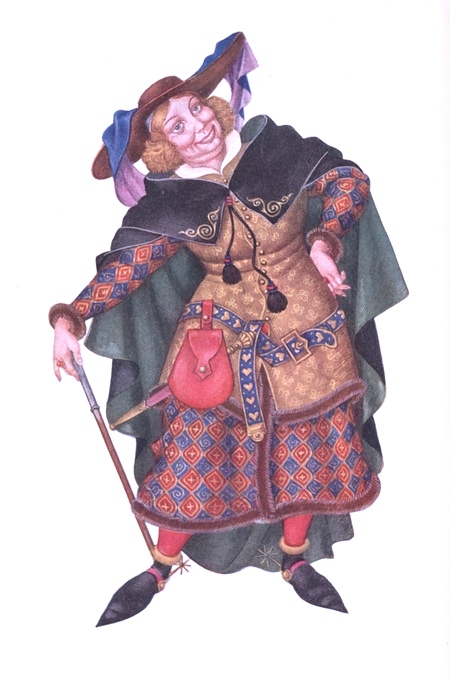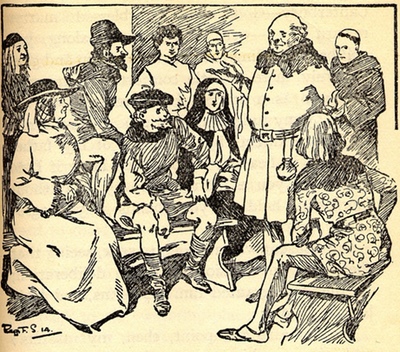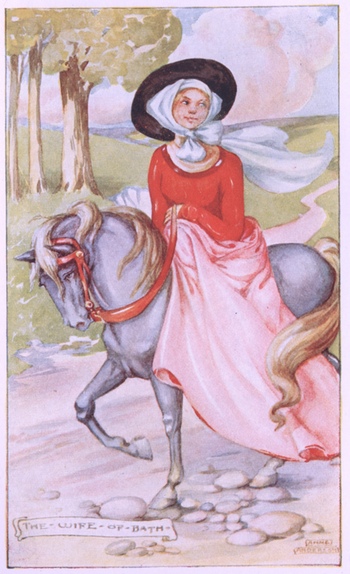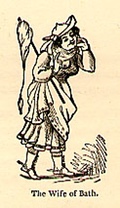
Adapting the Wife of Bath
Like Griselda, Chaucer’s Wife of Bath has been the subject of many rewritings, in translations, adaptations, and illustrations. Her description in the General Prologue; her own Prologue; and her tale all offer later adaptors opportunities to direct a reader’s view of her. Pictures, too, can be part of this direction. On this page I offer you some of the many resulting readings of the Wife.
An early adaptation of Chaucer for children, Charles Cowden Clarke’s Tales from Chaucer (1833), offers the Wife’s tale, but omits her Prologue completely. The text was frequently reused in later printings. The illustration to the right, by R. F. Smith, probably dates to 1911. The image above, in the title to this page, is by the American artist Arthur Szyk (1894-1951), and one of the books in which it appeared was a Heritage Bookshelf edition, from 1947, of the adaptation by Cowden Clarke. The Szyk illustration is reproduced with the cooperation of the Arthur Szyk Society www.szyk.org.


Illustrations of the Wife often feature the elaborate hat and scarves referred to in the General Prologue. The illustration to the left, by Anne Anderson (1874-1930) for the 1902 Gateway to Chaucer, is unusual in presenting the Wife as young and pretty.
Many adaptations/ translations include only parts of the Wife’s Prologue. J. Walker McSpadden’s Stories from Chaucer (1907), makes the most dramatic reduction:
Just then he espied the fat contented face of the Wife of Bath, and so he asked her for the next.
That worthy dame was so pleased at being allowed to talk that, instead of her story, she launched into her entire past history and that of the five husbands she had married– and buried, one after another.
The Friar laughed heartily at this long preamble– for which our Host took him to task.
The illustration to the right is based on the Ellesmere manuscript illustration of the Wife, and appears in McSpadden’s adaptation of the General Prologue. While that section, unlike the Wife’s Prologue, is not abridged, the translation is nevertheless also an interpretation:
But I must tell you more about the WIFE OF BATH. I am sorry to say she was somewhat deaf, but she was so expert at weaving cloth that no one could equal her. She allowed no other woman to outdo her in church worship, and she had been on pilgrimages to Rome, as well as travelled in many lands. Fair was her face and ruddy. The worthy woman had buried five husbands in her time. That she was well-to-do might be seen by her showy dress. Her hat was as broad as a buckler or target. She sat easily upon her ambling steed and could laugh and gibe in good fellowship with the best of us.
F.J. Harvey Darton combines the portrait of the Wife from the General Prologue with her self-portrait in her Prologue: the passage below is from his Story of the Canterbury Pilgrims (1914) (also published as Tales of the Canterbury Pilgrims, 1904); the illustration is from the 1904 edition.
THE little company had ridden some way without interruption when suddenly the Wife of Bath broke the silence.
“I will tell next,” she said in a loud voice, being herself a little deaf. The good wife had journeyed far from her home in the West Country, where she was famous for her skill in making fine cloth such as that part of England manufactured. She knew a great deal about traveling, for she had seen many a distant land and noble city. She had visited Boulogne, Cologne, Rome, and Spain, and had been as far as Jerusalem three times. She was a good and worthy woman, well pleased with herself and charitably-minded, unless her neighbors tried to set themselves above her or take precedence of her at church; if they did that, she grew so angry that she forgot all her Christian charity. She was gayly dressed for the pilgrimage, with bright scarlet hose and head-kerchiefs of the finest linen, weighing, perhaps, some ten pounds or more. Her shoes, too, were soft and new, and she wore a large riding skirt. She had been married five times, she now told the pilgrims, by way of introduction to her tale. She had done with all her husbands just as she wished, but the fifth, a student from Oxford, put her to some pains before she subdued him. He was always poring over books, she said, and now and again would read out aloud to her a story about the wickedness of some woman. But one day when he did this she lost her temper, and tore some leaves out of his book, and caught him such a buffet that he fell off his stool into the fireplace; whereupon he got up in a rage and knocked her down. When, however, he saw that she lay quite still, as if dead, he was sorry, and knelt down by her side and begged her forgiveness. But she started up out of her swoon and hit him a great blow on the side of the head, and ever after that she had no more trouble with him. All this she told the pilgrims at great length, without ever coming near her story, and the whole burden of her talk was the way to rule a husband. The Friar at last grew impatient.
 “Well, sirs,” said she, “nobody can speak better than I of the miseries of marriage; for since I was twelve years old I have been to the church door with five husbands, thank God, and all good men of their kind. True enough, Christ went but once to a wedding in Cana; and by that you may say I should have been married only once. But look at King Solomon! He had more than one wife, and I've the right to at least half his number, in husbands. So thank God for my five, and welcome to the sixth, when he comes along. When did God ever command a woman to keep single, tell me that! White bread for maids, barley bread for wives– and barley bread’s as good as white bread, any day. No! Husbands I must and will have, and as long as I live I’ll be my husband’s master.”
“Well, sirs,” said she, “nobody can speak better than I of the miseries of marriage; for since I was twelve years old I have been to the church door with five husbands, thank God, and all good men of their kind. True enough, Christ went but once to a wedding in Cana; and by that you may say I should have been married only once. But look at King Solomon! He had more than one wife, and I've the right to at least half his number, in husbands. So thank God for my five, and welcome to the sixth, when he comes along. When did God ever command a woman to keep single, tell me that! White bread for maids, barley bread for wives– and barley bread’s as good as white bread, any day. No! Husbands I must and will have, and as long as I live I’ll be my husband’s master.”“Three of my husbands were good, and two were bad; two of them were rich and old, as well as good. Lord! I can’t help laughing when I think how I kept ‘em under my thumb. They gave me everything they had in lands and money; but they’d never ha’ got the Dunmow Flitch in Essex. Oh, I knew how to govern ‘em, and make ‘em bring me gewgaws from the fair! They were only too glad when I spoke nicely to ‘em, for, Lord knows, I could scold like a shrew! I loved my fifth husband the best. His name was Jenkyn, and he had been a clerk. Before we were ed I would walk with him and my gossip in the fields. But after we were wed he would read all night in a book full of tales, about Even who brought mankind to wretchedness, and Samson who had his hair cut while he slept, and Hercules who set himself afire, and Socrates who was troubled with two wives, and Lucy who poisoned her husband– but you’d never suppose how much his reading vexed me! One night, all of a sudden, I tore three leaves out of his book, and struck him on the cheek so that he fell over backward. Then up he jumped and knocked me down, and I lay on the floor as though I was dead. That gave him a fright! He would have made off, but I came out of my swoon and said, “You’ve killed me, you thief, all to get my money! Yet I’m not so dead that I can’t kiss you.’ So he came and kneeled down by me and said, ’Dear Alison, I’ll never strike you again. But it was all your fault’. So I hit him on the cheek again, and said, ’Take that, thief! Now I am dead, and can’t speak a word’. But there! we made it up at last, and he let me have my way in everything, and he burnt that book inn the fire. God bless me! I was as kind a wife to him as you would find from Denmark to India. Rest his soul in peace. And now, if you like, I’ll tell you my tale.”

This detail of the Wife is taken from an illustration by Mary Eliza Haweis to her Chaucer for Children: A Golden Key (1877).
“Even if there was no authority to back me, my own experience, I can tell you, would give me the right to speak of the trials of marriage. Why, since I was twelve I have had five wedded husbands, and now I am a widow again I am quite ready to welcome the sixth. God meant me to marry and I shall do my duty; but I shall always rule my husband.”
“Well, as I was saying, five husbands have I had, and three were good and two bad. By good, I mean that they were old and rich, and gave themselves up to me body and soul, for they loved me well, and had given me all their property.”
“Now for the two of them that were bad. The first bad one was my fourth husband. He was gay; but I tell you I could be gayer, and between us things came to a pretty pass. However, in the end I went on a pilgrimage to Jerusalem, and when I came back it pleased God that he should die, and I buried him as he deserved, and God rest his soul. My fifth was a scholar. He had studied at one time at Oxford and then came to live with a neighbour of mine. I had met him before, but I first really loved him at the funeral. I was weeping, or doing my best to pretend to, and had my handkerchief over my face, but looking out under it I noticed his legs and feet as he was walking along in the procession, and prettier legs, I swear, I never saw. ‘Tis true he was only twenty and I forty, but I was buxom enough and had money and looks. At the end of the month we were married. O dear me, what a life I led with him! It was I who was infatuated this time, alas! I made over to him all my property, and much I repented that. Not one thing would he do that I wished, and worse, he once boxed my ears so hard that I became quite deaf. At the same time I would not give in to him, and though he threatened to leave me and quoted the authority of the ancient Romans for doing so, I stuck to my own way of life.”
“And now I’ll tell you why I tore the pages out of his book. He had a book he was always reading and laughing at. A great many authors’ works were bound up in it– Valerius and Theophrastus and a cardinal of Rome named St. Jerome, and other bishops, and Tertullian, also the parables of Solomon and Ovid’s ’Art of Love’. They were all tales of wicked wives, and he knew them better than all the stories of virtuous women in the Bible. And of course this is how it would be! All these tales are written by men and scholars. Now if women wrote them, very different they would be.”
“Well, as I was saying, one evening he read these to me, Eve and Delilah and the death of Hercules and countless more till I could bear it no longer, so I snatched his book and tore out the pages. Then up he jumped and gave me taht blow on the head that I told you of, that made me deaf, and I fell down on the floor as if I was dead. Then he was terrified till I woke a little out of my swoon, when he came near and kneeled down by me and said, ’Dear sister Alison, forgive me; before God I will never smite thee again. This time it was your own fault as you know’.”
“Well, to make a long story short, though it took us a long time, we made an agreement. He gave the management of all the affairs into my hands, and he even burnt his book and was very polite when I was there. So when I had my wish we had no more quarrels, and you would never find a better wife than I made him if you were to search from Denmark to India. Now I will tell my tale.”
It is common to talk about how a tale reflects (on) the teller in the Canterbury Tales; in that light, it is interesting to see what has been done to the Wife’s Tale in the adaptations I have drawn on above. The issue of violence in both the Prologue and the Tale, for example, is a common concern of current critics, but it is something which is often glossed over in the adaptations. What follows are excerpts from the opening of the Tale describing the rape; I’ve also included three modern children’s adaptations at the end of the list:
It happened that in the court of King Arthur dwelt a handsome and vigorous young bachelor knight, who, on his return one day from a hawking party of water-fowl, saw before him a young maiden, whom in a transport of wilfulness and brutality he ill-treated. The unmanliness and violence of the deed raised such a clamour, and so keen a pursuit of the offender, that he was seized, tried, and condemned to lose his head. (Cowden Clarke, 1830)
It happened that there was at King Arthur’s Court a young knight, in the full vigor and pride of his strength, who one day, as he was riding out, came upon a maiden walking all alone. She was very beautiful, and the sight of her made him forget his knighthood. He went up to her, and tried to carry her off with him by force. But before he could succeed help came, and he was seized and taken before the King. (Darton, 1904)
But back in the days of good King Arthur, that I am telling you about, it so befell upon a day that a brave knight of the court came riding along by a river. He was in sore trouble, for he was in disgrace and banishment. He had sinned grievously against the laws of chivalry of the Round Table, and King Arthur had condemned him to die. (McSpadden, 1907)
In those old days a goodly knight once fell into sin through the charms of a lady, and was tried for his crime and condemned to death. (Sturt and Oakden, 1923)
True to her character of managing wife, she then related a tale showing how much better it is when a wife has her own way. As a punishment for an offence he had committed, a Knight of King Arthur’s Court is sent into the world by the Queen to find out what it is that women most desire. (Dorothy Martin, A First Book About Chaucer, 1930)
Well, it so happened that this King Arthur had among his knights a jolly young fellow, who, as he came riding one day from hawking, insulted a maiden he found walking along. For which he was condemned to lose his head. (Farjeon, 1930)
Oxford University Press published an interesting adaptation of the Tales in 1984, but will not allow me to offer a short quotation from it here. You could go to the Library to consult Geraldine McCaughrean, The Canterbury Tales, 1984.
It so happened that King Arthur had in his court a young man who one day was riding by a river. He saw a maiden walking all alone. In spite of all she could do, he forced himself upon her. This oppression stirred up a lot of noise. (Barbara Cohen, Canterbury Tales, 1988).
Long ago, back in King Arthur’s time, there lived a Knight known for his love of pleasure. Riding by the river one day, he met a pretty girl walking by herself and, ignoring all her pleas, he threw her to the ground and raped her. King Arthur, when he heard of it, was outraged, and condemned the man to death. (Selina Hastings, A Selection from The Canterbury Tales, 1988)

While adaptations are generally reluctant to be clear about the rape with which the tale begins, they often dwell visually on the wedding-night revelation of the beautiful young maiden. This revelation is of course a staple of the Loathly Lady stories, of which the Wife’s tale is an example (click here to visit our course page on these stories). For example, the picture to the left shows Sir Gawain seeing Ragnelle in Sidney Lanier, The Boy’s Percy (1882).
Below is Sir William Russell Flint’s illustration to the Wife’s Tale from the 1913 Medici Society edition of the Tales.
